Intelligent Buildings: Efficiencies and Expectations
A quick look at the evolution of intelligent buildings, seen through the eyes of a campus project manager.
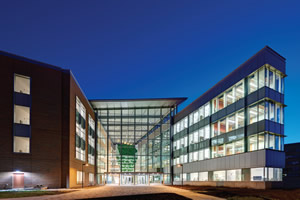
PHOTOS COURTESY OF IOWA STATE UNIVERSITY
With more than 20 years of using technology and process to create facilities that are efficient, safe and productive for their occupants, intelligent buildings are not new. College Planning & Management recently caught up with Kerry Anne Dixon, LEED-AP BD+C, a project manager with a bachelor’s in architecture who serves as coordinator of Sustainable Design and Construction for Iowa State University in Ames, where she has worked since 1995, about the efficiencies gained and how intelligent buildings are living up to expectations on her campus. A member of APPA: Leadership in Educational Facilities, Construction Owners Association of America (COAA), and the U.S. Green Building Council (USGBC), for which she is the university’s representative, here’s what she has to say.
CPM: WHAT ARE INTELLIGENT BUILDINGS?
DIXON: To me an intelligent building is one that uses the technology available to improve its operation. One nice thing about it is that the technology means you don’t necessarily have to have a body there all day every day making sure the building systems are doing what they’re supposed to do. You can have someone remotely monitor alarms but, once the programs are in place, the building tells you when something is not quite right and, many times, that is before a person calls to complain.

PHOTOS COURTESY OF IOWA STATE UNIVERSITY
CPM: HOW HAS THE CONCEPT OF INTELLIGENT BUILDINGS EVOLVED THROUGH THE LAST 20 YEARS?
DIXON: It has been amazing. When it first started, there were temperature controls. Now there are more and more things you can control within the building, such as lighting and occupancy, allowing you to be more responsible to the environment both inside and outside the building.
CPM: HOW HAS THE TECHNOLOGY THAT CREATES INTELLIGENT BUILDINGS IMPROVED IN THE LAST 20 YEARS?
DIXON: The technology went from where you practically had to be a computer programmer to figure out things that only existed in each specific building to what we have now, which is the ability to interface with the building systems via an app on a smartphone. A building tech can simply launch an app from across campus or town, or even across the country, to see if everything is running as intended.
One nice thing in the last 10 years of development is how building systems interact with user portals. Building occupants can see a dashboard of what’s going on in the building. They can’t tweak it, but they can see the energy that’s being consumed, change their behavior and see consumption immediately drop.
CPM: TELL ME ABOUT YOUR CAMPUS’S HISTORY WITH INTELLIGENT BUILDINGS.
DIXON: We go back to some of the earliest buildings on campus having pneumatic control systems in them, so that you could tweak the thermostat and it would release or shut down the radiator in your office space. As we began to renovate facilities, we would upgrade by digitizing systems and tie them into a central building controller. Now when we upgrade a building, it connects to a central brain within the campus network. So pretty much every building on campus is tied to our central control system whereby we can see such things as temperature by room, wing and floor.
As we build new and renovate existing facilities, we’re bringing everything up to new technologies and changes in energy code. For example, now we’re tying lighting into the central control system to turn off all but emergency lighting off at a certain time, in the case that someone goes home and forgets to turn lights off.
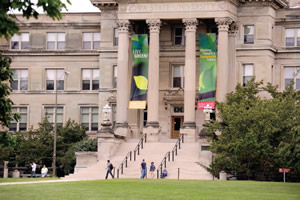
PHOTOS COURTESY OF IOWA STATE UNIVERSITY
Also, we take the things we learn from LEED-certified buildings and apply them to non-LEED projects, such as temperature controls, occupancy sensors, light sensors and how we work within a space.
Finally, we’re re-commissioning older buildings, making sure the control systems are operating correctly and up to date. Tweaking their operational systems allows them to operate better, resulting in additional energy savings.
CPM: GETTING MORE SPECIFIC, WHAT HAVE YOU MOST RECENTLY UPDATED, AND TO WHAT END?
DIXON: A year ago, we opened a new facility for the Agriculture and Biosystems Engineering Department. Previously, the department was in a facility rebuilt after a fire in 1942 and that had been cobbled together through the years. The new building offers state-of-the-art technology. For example, this department uses large equipment — think tractors and combines. This facility provides space to learn about the equipment. It has daylight sensors so artificial light responds to natural daylight. As you move deeper into a room, away from natural light coming through the windows, more banks of ambient task lights come on.
These are the second and third buildings of a three-building complex. The complex uses two cisterns and one filter system to reclaim water for flushing toilets and urinals, and the system has been up and running in the first building since 2009. It’s smart — no one has to physically monitor it — the controls do that for us. For example, when the cisterns are full, the overflow water goes into a rain garden and an alarm is sent automatically. In fact, in three years, only 130 gallons of potable water have been used to flush toilets and urinals in the first building.
In a lot of our facilities, we use carbon dioxide monitors to assist with determining if air needs to be cooled or heated, or simply recirculated. Here’s how it works. People breathe in oxygen and breathe out carbon dioxide. If a sensor senses a lot of carbon dioxide, it knows there are people in the space and can automatically adjust the fresh air in air conditioning or heat to keep them comfortable. If carbon dioxide levels are low, it knows that not many people are in the building, and it automatically recirculates existing air to keep the space comfortable. It has made a difference in how we consume energy on campus.
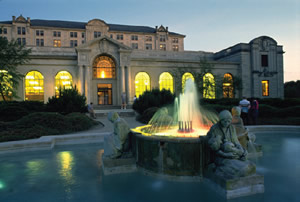
PHOTOS COURTESY OF IOWA STATE UNIVERSITY
CPM: WHAT PLANS ARE YOU MAKING FOR FUTURE IMPROVEMENTS?
DIXON: We’re adding controls for conserving lighting and outlet energy. Lighting motion sensors can pay for themselves in less than a month, literally. We’ve got a couple buildings that have equipment rooms full of freezers or refrigerators. The rooms are buried deep in the buildings in areas with no windows. People will go in, turn on the light and get supplies. They leave with their hands full, unable to turn off the light. If no one else goes in the space, the light can stay on for days. With a motion sensor, the light is turned off in a short amount of time.
With the outlet controls, half the outlets have to be able to be switched on and off; they can’t be on all the time. The point of this code is to get people to plug into dedicated outlets the things that need to be plugged in all the time and use outlets that can be turned off for things that don’t need to be on when no one is in the space, such as desk lamps and phone chargers. While this is a good thing, it’s challenging because it requires educating new occupants that an outlet will turn off if you’re not there.
Another thing we’re working toward is lighting improvements. We bill utilities per college, with public spaces such as restrooms, hallways and mechanical space being billed to the facilities department. In public areas, we’re changing from a fluorescent to an LED fixture, where additional savings are found because LED fixtures throw out more light and are more efficient. Instead of three fluorescent 2-by-4 fixtures, you can use two LEDs. We’ve started sharing with the departments the energy savings we’re seeing so that they can choose to garner savings as well.
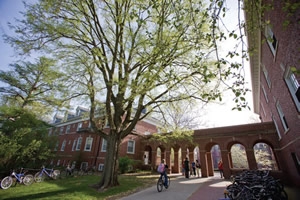
PHOTOS COURTESY OF IOWA STATE UNIVERSITY
For example, in some of our older buildings, we’re changing out T12 fluorescent light fixtures with T8s, which are more energy efficient. This can be done on a room-by-room basis. We’ve discovered that the change pays for itself in four months in any space. Also, if we change to an LED fixture with a motion sensor, the cost is saved in an additional three to six months but the long-term savings are higher.
CPM: IN YOUR EXPERIENCE AT IOWA STATE, HOW ARE INTELLIGENT BUILDINGS LIVING UP TO THEIR CAPABILITIES?
DIXON: What we’ve discovered, and it’s probably true on other campuses, is that our control systems can do a whole lot more than our people have the time to implement. Part of that is the sheer quantity of buildings we operate. We have 370 custodians, power plant operators, groundskeepers, and building maintenance professionals (carpenters, painters, electricians and mechanical specialists), who cover 5.6 million assignable square feet (approximately 12 million gross square feet).
Another part of it is the diversity of that staff by age. The facilities department has a total staff of 460, from which we average a dozen retirements per year. That’s a lot of new people to train and bring up to speed, not to mention the loss of institutional memory that comes with retirement. We recently had someone retire after 45 years; you can be sure he knew a lot of the older buildings’ quirks.
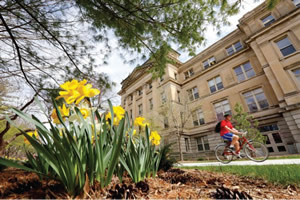
PHOTOS COURTESY OF IOWA STATE UNIVERSITY
The third part of it is how quickly the technology changes. As soon as you get someone trained, or every time you open a new building, you use lose productivity because you have to teach something else.
There’s more technology in your smartphone than in the original capsule that sent the astronauts to the moon. I think a lot of our buildings are working the same way, and that everyone agrees we’re not using the capability we have. I don’t know how to reconcile that. You have to balance your resources, and sometimes you simply don’t have the financial resources to do everything you can.
CPM: WHAT WISDOM WOULD YOU LIKE TO SHARE WITH CAMPUS ADMINISTRATORS ABOUT INTELLIGENT BUILDINGS?
DIXON: With the technology we’re able to put in our buildings, I think we have the opportunity to really assist administrators in making the environment better for the students we serve. And that’s not just by building a new building and putting the newest technology in it — it’s also through updating older buildings, which can be a hard sell because the technology is not visual. Yet, if we can refine how our buildings operate, we can free money to address core education areas. We’re always going to have a built campus environment, so let’s use available technology to make that environment synergistic to promote learning and research.
This article originally appeared in the issue of .